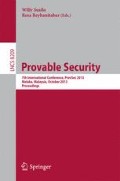Abstract
EAX is a mode of operation for blockciphers to implement an authenticated encryption. The original paper of EAX proved that EAX is unforgeable up to O(2n/2) data with one verification query. However, this generally guarantees a rather weak bound for the unforgeability under multiple verification queries, i.e., only (2n/3) data is acceptable.
This paper provides an improvement over the previous security proof, by showing that EAX is unforgeable up to O(2n/2) data with multiple verification queries. Our security proof is based on the techniques appeared in a paper of FSE 2013 by Minematsu et al. which studied the security of a variant of EAX called EAX-prime. We also provide some ideas to reduce the complexity of EAX while keeping our new security bound. In particular, EAX needs three blockcipher calls and keep them in memory as a pre-processing, and our proposals can effectively reduce three calls to one call. This would be useful when computational power and memory are constrained.
Access this chapter
Tax calculation will be finalised at checkout
Purchases are for personal use only
Preview
Unable to display preview. Download preview PDF.
References
Bouncy Castle, http://www.bouncycastle.org/
Information technology - Security techniques - Authenticated encryption. ISO/IEC 19772:2009 (2009)
Bellare, M., Goldreich, O., Mityagin, A.: The Power of Verification Queries in Message Authentication and Authenticated Encryption. Cryptology ePrint Archive, Report 2004/309 (2004), http://eprint.iacr.org/
Bellare, M., Rogaway, P., Wagner, D.: The EAX Mode of Operation (A Two-Pass Authenticated-Encryption Scheme Optimized for Simplicity and Efficiency), http://www.cs.ucdavis.edu/~rogaway/papers/eax.pdf
Bellare, M., Rogaway, P., Wagner, D.: The EAX Mode of Operation. In: Roy, Meier (eds.) [17], pp. 389–407
Black, J.A., Rogaway, P.: CBC MACs for Arbitrary-Length Messages: The Three-Key Constructions. In: Bellare, M. (ed.) CRYPTO 2000. LNCS, vol. 1880, pp. 197–215. Springer, Heidelberg (2000)
Chakraborty, D., Sarkar, P.: A general construction of tweakable block ciphers and different modes of operations. IEEE Transactions on Information Theory 54(5), 1991–2006 (2008)
Dai, W.: Crypto++ Library, http://www.cryptopp.com/
Gladman, B.: http://www.gladman.me.uk/
Iwata, T., Kurosawa, K.: OMAC: One-Key CBC MAC. In: Johansson, T. (ed.) FSE 2003. LNCS, vol. 2887, pp. 129–153. Springer, Heidelberg (2003)
Krovetz, T., Rogaway, P.: The Software Performance of Authenticated-Encryption Modes. In: Joux, A. (ed.) FSE 2011. LNCS, vol. 6733, pp. 306–327. Springer, Heidelberg (2011)
Minematsu, K., Lucks, S., Iwata, T.: Improved Authenticity Bound of EAX, and Refinements. Full-version of Provable Security 2013 (2013), http://eprint.iacr.org/
Minematsu, K., Lucks, S., Morita, H., Iwata, T.: Attacks and Security Proofs of EAX-Prime. Pre-proceedings of Fast Software Encryption 2013 (2013), full-version available at http://eprint.iacr.org/2012/018
Rogaway, P.: Efficient Instantiations of Tweakable Blockciphers and Refinements to Modes OCB and PMAC. In: Lee, P.J. (ed.) ASIACRYPT 2004. LNCS, vol. 3329, pp. 16–31. Springer, Heidelberg (2004)
Rogaway, P.: Nonce-Based Symmetric Encryption. In: Roy, Meier (eds.) [17], pp. 348–359
Rogaway, P., Shrimpton, T.: A Provable-Security Treatment of the Key-Wrap Problem. In: Vaudenay, S. (ed.) EUROCRYPT 2006. LNCS, vol. 4004, pp. 373–390. Springer, Heidelberg (2006)
Roy, B., Meier, W. (eds.): FSE 2004. LNCS, vol. 3017. Springer, Heidelberg (2004)
Zeng, G., Han, W., He, K.: High Efficiency Feedback Shift Register: σ-LFSR. Cryptology ePrint Archive, Report 2007/114 (2007), http://eprint.iacr.org/
Author information
Authors and Affiliations
Editor information
Editors and Affiliations
Rights and permissions
Copyright information
© 2013 Springer-Verlag Berlin Heidelberg
About this paper
Cite this paper
Minematsu, K., Lucks, S., Iwata, T. (2013). Improved Authenticity Bound of EAX, and Refinements. In: Susilo, W., Reyhanitabar, R. (eds) Provable Security. ProvSec 2013. Lecture Notes in Computer Science, vol 8209. Springer, Berlin, Heidelberg. https://doi.org/10.1007/978-3-642-41227-1_11
Download citation
DOI: https://doi.org/10.1007/978-3-642-41227-1_11
Publisher Name: Springer, Berlin, Heidelberg
Print ISBN: 978-3-642-41226-4
Online ISBN: 978-3-642-41227-1
eBook Packages: Computer ScienceComputer Science (R0)

